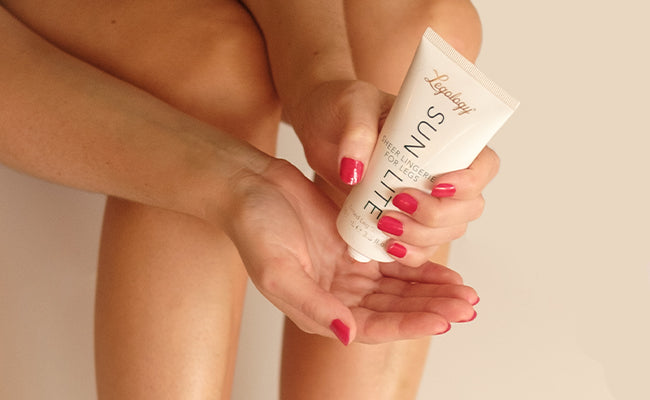
Cellulite, as we know, is not so much a fat issue so much as a manifestation of the way fat cells are placed and the environment around them. When the body becomes congested, and fluid collects around fat cells, it pushes them out of line and this is what creates the bumpy looks we’re so familiar with. This is compounded by loss of elasticity to the fibres that run between fat cells and hold them tight, and unfortunately all of this worsens with age.
So cellulite often first appears during young adulthood – at puberty, but also during other growth chapters like pregnancy and menopause; it’s especially prevalent in middle-age, usually developing in areas of the body that tend to store more fat, such as the upper arms, buttocks, and thighs.
Women tend to develop more cellulite than men because of the natural arrangement of our connective tissue and because we tend to have a higher percentage of body fat. In females, the bands of connective tissue and fat cells are thinner than in men and arranged vertically. In males, the bands of tissue are thicker and arranged in a criss-cross pattern, which keeps the fat from puckering through and creating cellulite.
It’s also thought that hormone decline and imbalance plays a role in the development of cellulite.
THE ESTROGEN DEFICIENCY-CELLULITE CONNECTION
Cellulite may appear anytime in a woman’s life. But when estrogen levels decline, cellulite may increase. Lower levels of estrogen may contribute to the development of cellulite in a few ways. For example, reduced estrogen may cause vascular changes, such as decreased blood flow to the connective tissue, increased permeability and fluid retention under the skin, which may all play a part in the development of cellulite. (2)
Decreased estrogen also may mean reduced production of elastin fibers and collagen, which keep the skin firm and toned. When levels drop, the connective tissue becomes weaker. The skin also becomes thinner. The combination of both factors is ideal for the development of cellulite. (3)
WHEN DOES ESTROGEN DECLINE IN A WOMAN’S LIFE?
Estrogen levels drop during menopause. But levels can also fluctuate for years prior to menopause during perimenopause. Perimenopause is the time leading up to menopause, and it can occur several years before a woman is considered post-menopausal.
During perimenopause, estrogen levels may be too low or too high. But these conditions can affect cellulite development. For example, estrogen dominance can develop during perimenopause, which can contribute to an increase in fat. More fat stored under the skin may increase cellulite.
During menopause, as estrogen declines, ageing skin is also becoming thinner and less elastic. Between decreased estrogen and sagging skin, it’s no surprise that many women notice cellulite increasing.
IS THERE A SOLUTION?
Although there are all types of anti-cellulite lotions and treatments on the market, studies are surprisingly limited over their effectiveness. Research that involved a meta-analysis of 67 journal articles containing information on in vivo human studies on the efficiency of cellulite treatments indicated no proven treatment. But some of the studies did not have a placebo control, which made them inconclusive, and none of them have been conducted alongside changes to diet and activity – the whole approach that I recommend with our Cellulite Plan.
Body-identical estrogen, taken as HRT, may help to manage weight and in doing so reduce or prevent cellulite by replacing the hormone that is missing.
Remember, estrogen affects the vascular activity of the skin, as well as fat levels and collagen production. By replacing estrogen and returning levels back to normal, it prevents changes in the tissue and skin that contribute to the formation of cellulite.
Our Cellu-Lite Salon Secret For Legs was made to treat the issue where it starts by enhancing the body’s natural detoxification process: it works to promote the lymph, which removes waste from the body and around the cells using a powerful blend of aromatherapy oils like Siberian fir, lemon, grapefruit, eucalyptus and juniper. It works brilliantly to smooth dimples, but it’s important to say that you will maximise the results you get if you take an inclusive approach to cellulite and follow these recommendations:
- Maintain a healthy weight: this is beneficial for your overall wellbeing, but remember, slim and fit people still develop cellulite. However, the more fat you have under the skin, the higher the chance it will push through the connective tissue and cause skin dimpling.
- Do strength training exercises: this firms your muscles and can improve skin tone, which in turn could decrease the appearance of cellulite.
- Don’t smoke: it damages your skin by disrupting the body’s ability to make collagen. It also decreases healthy circulation. The combination of both of those factors can make you more likely to develop cellulite.
- Take collagen supplements to keep your skin supple and elastic.
- Use a body brush like our Lymph-Lite Boom Brush For Body: it improves blood and lymphatic fluid flow to the skin and works so well to improve areas of cellulite and you don’t have to use it vigorously to have an impact – in fact the gentler you are the better.


